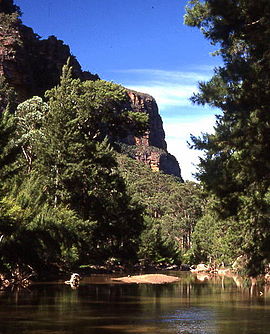| Wollemi National Park New South Wales | |
|---|---|
 Capertee River, located within the southern portion of the national park | |
| Nearest town or city | Lithgow |
| Coordinates | 32°52′26″S 150°29′32″E / 32.87389°S 150.49222°E |
| Established | December 1979[1] |
| Area | 5,017 km2 (1,937.1 sq mi)[1] |
| Managing authorities | NSW National Parks and Wildlife Service |
| Website | Wollemi National Park |
| See also | Protected areas of New South Wales |
The Wollemi National Park (/ˈwɒləmaɪ/)[2] is a protected national park and wilderness area that is located in the Central West and Hunter region of New South Wales, in eastern Australia. The 501,703-hectare (1,239,740-acre) park, the second largest national park in New South Wales, contains the 361,113-hectare (892,330-acre) Wollemi Wilderness – the largest such wilderness area in Australia[3] – and is situated approximately 130 kilometres (81 mi) northwest of Sydney.
The Wollemi National Park is one of the eight protected areas that, in 2000, was inscribed to form part of the UNESCO World Heritage–listed Greater Blue Mountains Area.[4] The Wollemi National Park is the most north–westerly of the eight protected areas within the World Heritage Site. The national park forms part of the Great Dividing Range.
Due to the park's ruggedness, much of it is undiscovered by humans and the many canyons have yet to be explored.[5][6] The only known living wild specimens of the Wollemi pine (Wollemia nobilis) were discovered in 1994.[7] Special efforts were made to protect the trees when the 2019-20 Australian bushfires burned through the park.[8]
The national park is bounded to the north by the Goulburn River National Park and the Bylong Valley Way; to the east by the Yengo National Park, the Parr State Conservation Area, and the Putty Road; to the south by the Blue Mountains National Park and the Bells Line of Road; to the south–west by the Wolgan Valley and the Gardens of Stone National Park; and to the west by open farmland that surround the towns of Rylstone and Kandos and the Capertee Valley.[9]
- ^ a b "Wollemi National Park: Park management". Office of Environment & Heritage. Government of New South Wales. Retrieved 3 October 2014.
- ^ "Wollemi pine". ABC Pronounce. Australian Broadcasting Corporation. 19 October 2005. Retrieved 19 July 2020.
- ^ Greater Blue Mountains World Heritage Area: Strategic Plan (PDF) (PDF). Government of New South Wales. January 2009. p. 15. ISBN 978-1-74122-960-8. Retrieved 3 October 2014.
{{cite book}}:|work=ignored (help) - ^ "Greater Blue Mountains Area". World Heritage List. UNESCO. 2014. Retrieved 31 August 2014.
- ^ Debus, Bob (April 2001). "Wollemi National Park Plan of Management" (PDF). NSW National Parks & Wildlife Service. Retrieved 15 May 2024.
- ^ "NATIONAL PARKS". Denman CTC. April 2015. Retrieved 15 May 2024.
- ^ Cite error: The named reference
Mattilawas invoked but never defined (see the help page). - ^ Wamsley, Laurel (16 November 2020). "Aussie Firefighters Save World's Only Groves Of Prehistoric Wollemi Pines". NPR News. Retrieved 17 January 2020.
- ^ "Wollemi National Park". Office of Environment & Heritage. Government of New South Wales. Retrieved 3 October 2014.
